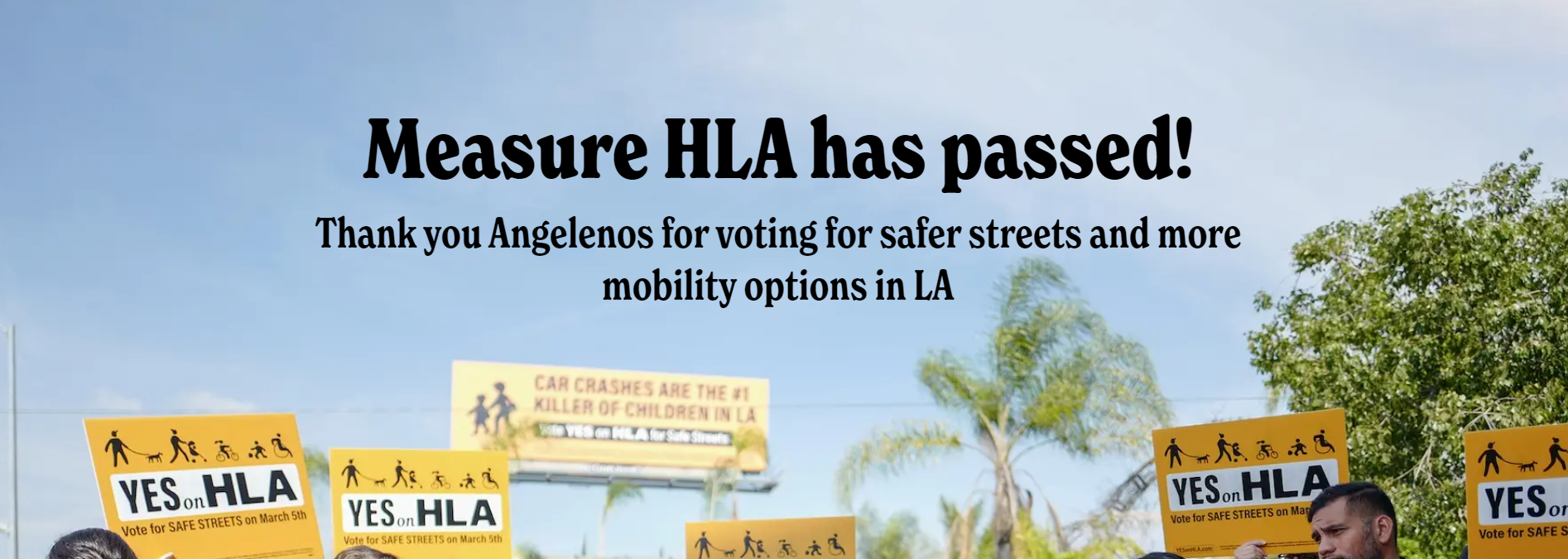Unraveling Measure HLA: Your Essential Guide to Understanding its Impact
TLDR: We break down the Impact of Measure HLA and how this IS revolutionizing the streets of Los Angeles…
Heads up, LA! Our streets are about to get a major makeover, and it's all thanks to Measure HLA. You know, that ballot measure we all voted on? Basically, it's a game-changer for how we get around. But you're probably wondering, 'Okay, what exactly does that mean for me?' Let’s break it down.
Here’s the scoop:
So, the goal here is simple: make LA streets safer and easier to use for everyone, not just cars. Measure HLA? That's the engine driving this change. A solid 63% of us said 'yes' to it, which is huge! Basically, it means that when the city repaves a street, they've also got to think about adding things like better sidewalks, bike lanes, and bus improvements. It's all part of this master plan called Mobility Plan 2035.
What Measure HLA does:
Think of Measure HLA as the city's promise to stick to that Mobility Plan. When they fix our roads, they've got to follow the blueprint. And that blueprint is all about making it easier to walk, bike, or hop on public transit. It's not about banning cars, don't get me wrong. It's about giving us real alternatives so we're not always stuck in traffic.
How it works:
Who's actually doing the work? Well, Streets LA (you might know them as the Bureau of Street Services is going to be the main crew fixing our roads. Then, Metro and Los Angeles Department of Transportation (LADOT) are stepping in to add those bike lanes and bus lanes. Teamwork makes the dream work, right?
What's coming up:
Okay, let's be real, you're not going to see brand-new bike lanes popping up overnight. This is a long-term project. But over time, as they fix our streets, you will start noticing those improvements. More bike lanes, wider sidewalks, the works. It's all about making LA a safer and easier place to get around.
Keeping track:
You can stay updated on the progress of these changes through:
- Streets For All, a group that watches over the Mobility Plan
- Streets LA's map showing which streets are getting fixed
- LADOT's website, where they share updates on their safety efforts.
With the fundamentals in place, it's time to explore the deeper impact of Measure HLA. We'll examine how it's poised to transform Los Angeles' street infrastructure and what changes residents can expect
Unveiling Measure HLA: Enhancing Safety and Accessibility
With Measure HLA now a reality, LA's streets are about to get a major upgrade. We're talking safer roads for pedestrians, cyclists, and drivers – a real win for everyone. But what exactly is in this measure, and how will it transform our daily commute?
The Backbone of Measure HLA: Understanding its Background
Los Angeles decided it's time to make our streets work better for everyone, not just cars. Measure HLA, which got a strong 63% approval, is the key. It means that whenever they're fixing our roads, they've got to build in improvements from the Mobility Plan 2035. That's things like more bus and bike lanes, and wider sidewalks, so we have more options for getting around.
“This is being watched nationally,” Boarnet told the Los Angeles Times. “It’s a signal across the country that people really value streets where, yes, they can drive, but they could also walk, they could also bicycle.”
Expert Insights: Marlon Boarnet's Take
Even experts are talking about how big a deal Measure HLA is. Marlon Boarnet, who heads up the METRANS Transportation Consortium at USC, pointed out that it's a sign of a national shift. We're finally realizing that streets aren't just for cars anymore – they need to work for everyone, walkers and bikers included.
Navigating Measure HLA: Understanding its Implications
The core idea behind Measure HLA is simple: when the city fixes streets, they have to align with the goals of the Mobility Plan 2035. That means building a network where you can easily walk, bike, or take transit. The goal isn't to take away from cars, but to give us safer, more convenient ways to get around without them.
Empirical Evidence: Insights from METRANS Research
METRANS research really backs up the idea behind Measure HLA. They found that 'slow streets' during the pandemic led to a noticeable increase in people choosing to walk or bike. And if you look at how people use shared electric scooters, it's clear: build the infrastructure, and people will use it for non-car travel.
Executing Measure HLA: Stakeholders and Responsibilities
To make Measure HLA a reality, different city departments are working together. Streets LA, the people who fix our roads, are going to be repaving them. Metro and LADOT, which is the Los Angeles Department of Transportation, are going to be in charge of adding bus and bike lanes.
The Road Ahead: Anticipating Transformations
Measure HLA is a big step, but it's going to be a gradual process. You'll start to see those changes happening over time, as they work on street maintenance and follow the goals of the Mobility Plan 2035. Basically, expect to see more bike lanes and bus lanes added as they fix roads or do utility work.
Tracking Progress: Stay Informed
Even though we don't have all the official city data yet, there are ways to keep track of how Measure HLA is coming along. I've been checking out Streets For All, which has trackers for the Mobility Plan, and Streets LA's map to see what roads are being worked on. Plus, LADOT's website has updates on their Vision Zero safety work.
All links to organizations will be provided in What’s the scoop
